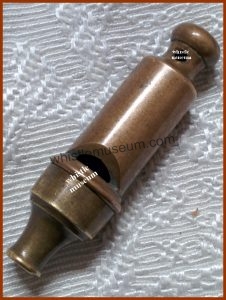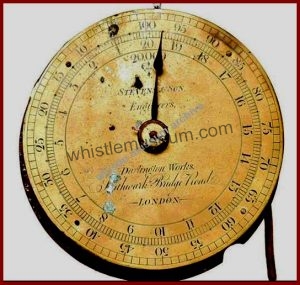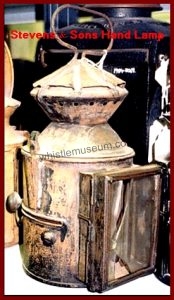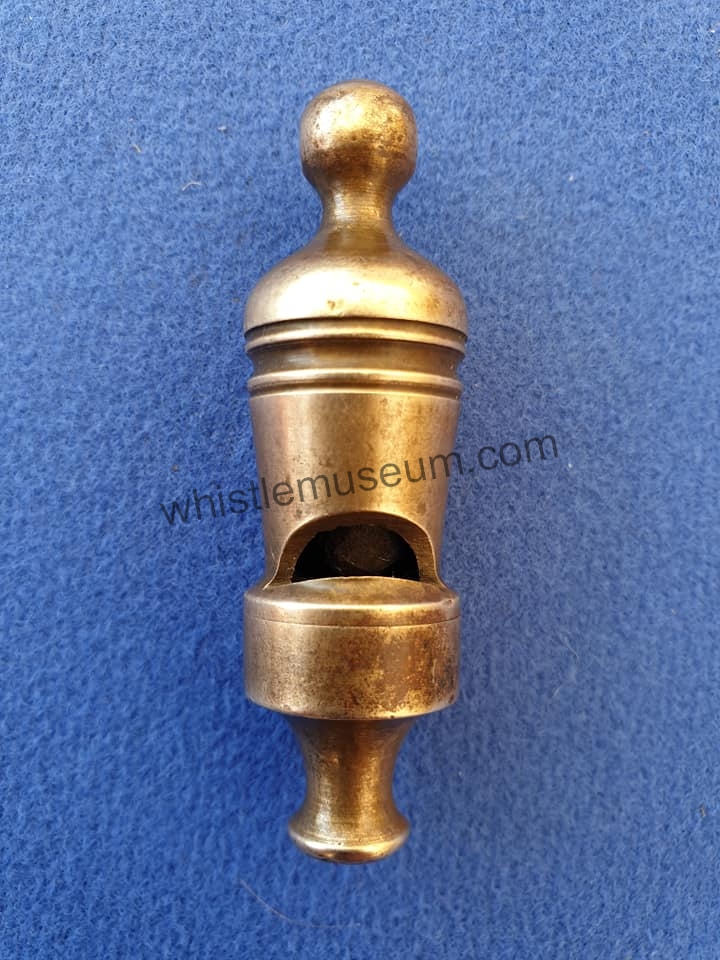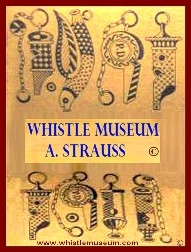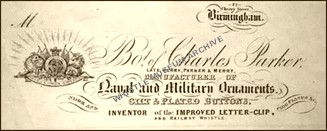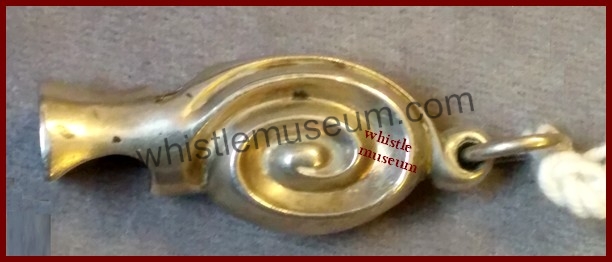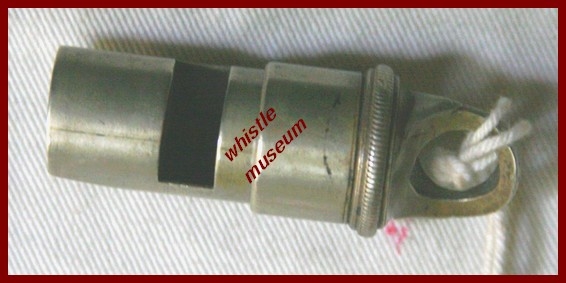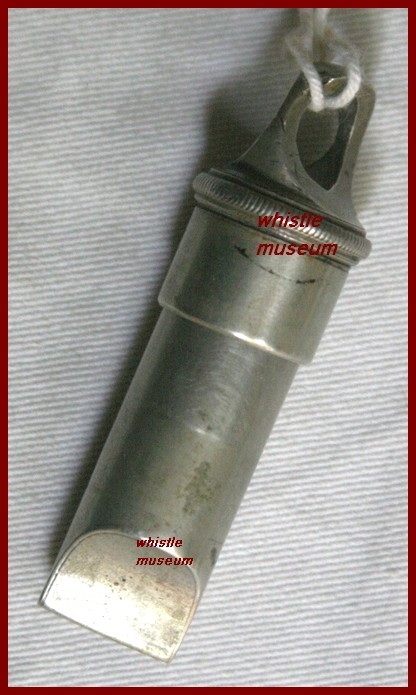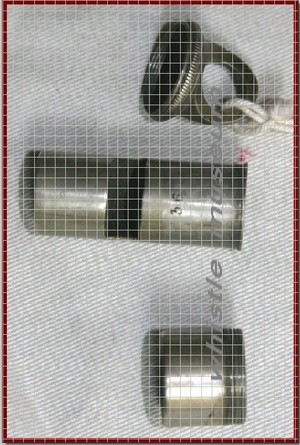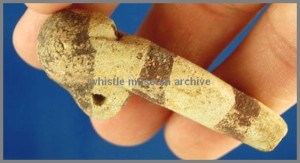 Ancient Latin American Clay whistle which clearly resembles the early bosun whistles.
Ancient Latin American Clay whistle which clearly resembles the early bosun whistles.
* originally published in the whistle museum old website, The web site had
about 500 articles and 1000’s of photos I hope to reload many of these in the future.
** In the 19th century and earlier the common word used for whistle was CALL
this changed in the 20th Cent. but the Boatswain’s pipe , Bosun pipe call
kept its name as CALL , it seemed to me right to simplify it into BOSUN WHISTLE .
Content.
* Late Medievel and Post Medievel examples. 14th to 18th cent.
* General history and Myth
* Parts and Construction
* How To Blow the Bosun whistle command calls, its
Musical use, and Mp3 samples.
* 19th Century Examples by Decades 1870 to 1910’s
and Makers.
* 20th Century- Professional Makers, Souveneir types
and ones used in actual service and as presentation
whistles.
* Reference to previous articles here
Medieval and post medieval times examples
14th Century
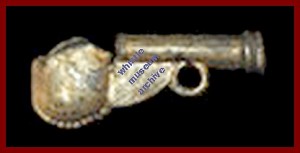
40 mm Brass c 14th century.
15th century
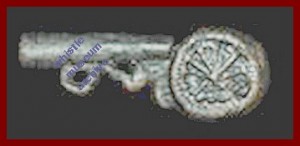
Heavy brass 81 grams length 39 mm.

Cast metal, second half of 16 century
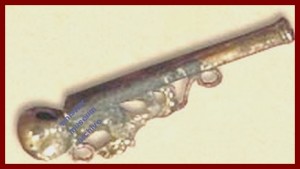
Note Ornamental keel mixed wire and cast parts.I believe this one is in the British Museum . cast plated metal.
From the Portrait of a Man with a Lute at the Maritime museum Greenwich by
Hans Holbein the Younger (c. 1497 – between 7 October and 29 November 1543) was a German artist and print maker who worked in a Northern Renaissance style. He is best known as one of the greatest portraitists of the 16th century’
we can see an earlier 16th Century Bosun whistle which is in already in the developed shape still used today. I thank Mr. Bron Larner for his comment .
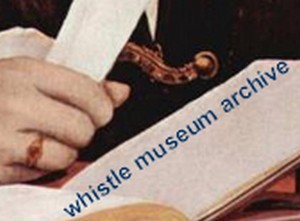
–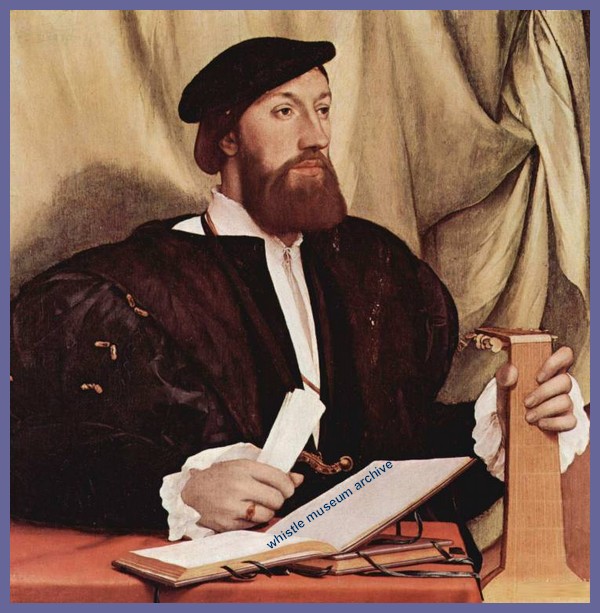 In addition you may see a painting by Lucas Cranach the elder with a different style bosun whistle of the same era LOOK
In addition you may see a painting by Lucas Cranach the elder with a different style bosun whistle of the same era LOOK
17th Century
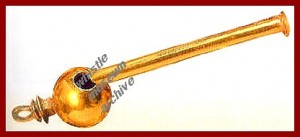
Boatswin’s pipe, Buson’s pipe whistle, gold early part of 17th century c 1610’s found near the spanish boat Margarita that sank at 1622, see the Attocha ship whistle here.
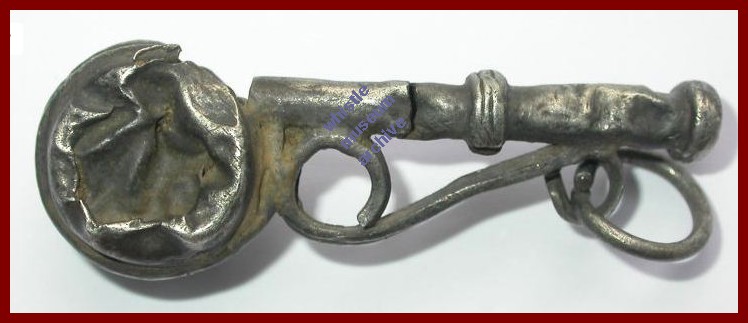
A Keel of heavy wire. and ring around pipe, Silver. not sure about the date but similar to 15th century designs.
18th Century
1770’s
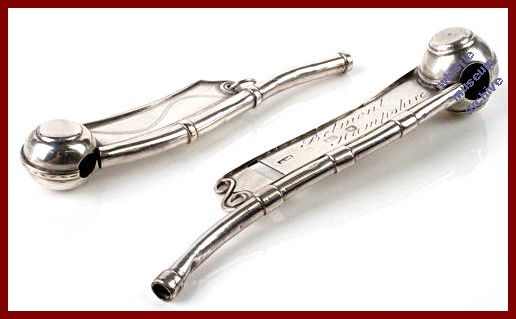
1776 A George III Maker mark ‘M.F’, London.
1880’s
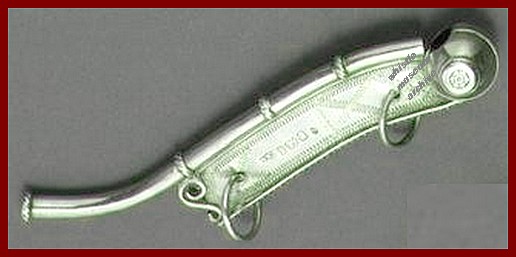
1784 Hester Bateman London Hall Mark
Scroll down to See 19th Century time line by decades
General History and Myth
The boatswain’s call is a none diaphragm aerophone and has it’s history tied to naval and marine usages.
It has a long history both as a symbol of office and as a practical instrument for conveying orders at sea and playing music to pass time at sea.
It became a standard in navy and military boats all over the world and on each boat there was a sailor an Officer who had to know the various call codes and in charge of using the whistle to convey commands and blow it on certain parts of the day to mark daily choirs and for ceremonies. See next chapter.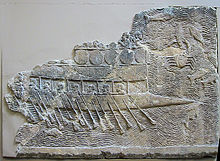 Assyrian warship, a bireme with pointed bow. 700 BC
Assyrian warship, a bireme with pointed bow. 700 BC
Its distinctive shape has remained practically unchanged from medieval times to the present day. The call’s shrill whistle can be varied in pitch and duration to convey a variety of information, and can be heard above the sound of wind and sea. Such instruments were private possessions rather than official equipment and silver calls like this one made suitable gifts and presentation pieces.
The boatswain’s call has a long history and goes to ancient times, myth has it that roman boats had a man who gave rhythm with a whistle to the rowers in Galeys war boats that had as many as 12 and more rowers on each side and had to row in rhythm .
During the years many names were used and Buson pipe, call or whistle became the most used.
Parts Construction and How to Play

Traditionally the Bosun’s pipe has 5 parts named
The Gun
The Buoy
The Keel
The Hole
The Shackle
Being a none diaphragm type whistle the Gun – pipe and the Ball with the hole – Buoy are the main parts and enough to produce a great whistle.
The Keel that is made for understrengthening of the Gun- pipe functions as an ornamental part as well, ( Same idea as in Escargot type whistles London type Old Button type construction and Glasgow type.) Some bosun calls do not use a keel .
Three sets of rings around the pipe which vary in number and shapes (a wide loop at times) became a part of the traditional English Buson around mid 18th century.
How To Blow The Whistle, command calls, Playing Music and Mp3 Samples
The Buson Pipe is a whistle that uses the hand and fingers to manipulate the sound, it is capable of playing all the notes within an Octave range (12 notes) and needs practicing.
As in flutes silver gives a better whistle sound .
It needs practicing to be able to control al the notes and be able to play melodies, old sailors had much time to kill on boats and sea vessels and music was a great way to pass the time when meditating over monotonous marine landscapes, on voyages that lasted monts at a time.
I did actually meet an old bearded Irish sailor who was a virtuoso in playing these.
There is a Huge difference in the sound quality of these pipes from ones that hardly make a sound to others that sound like magic flutes.
The code used to convey orders on sea vessels usese a general High – Low Pitch and Long – Short duration notes. It does not use all its musical possibilities.
The Palm and fingers are used as an extra sound Chamber, the larger and more open it is the lower the pitch, By lowering each finger the musical note pitch varies, Thus one has to actually try slow and learn by practicing, I suggest starting with simple melodies and sea shantys, an instructional Video and samples of simple tunes is something I hope to make in the future.
Direction and More about playing here
Open position
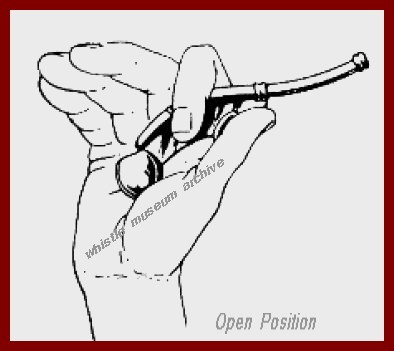
Closed Position
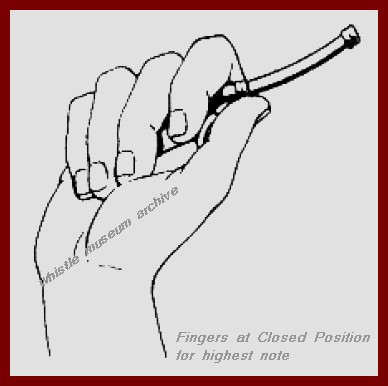
Special effects
- Warble: The warble is produced by repeatedly moving your hand quickly from the high to the low position, which results in a warble similar to that of a canary.
- Trill: The trill is produced by vibrating the tongue while blowing, as in rolling the letter R.
From Sea Scouts ” As we’re Sea Scouts, we use the Bosun’s Call or Boatswain’s Call for ceremonies. It’s mainly used at Flag Break and Piping Aboard VIPs.In order to produce a low note The Bosun’s Call is held by the index finger and thumb in the right hand with the Buoy resting in the palm of the hand while youre remaining three fingers raised above the gun has shown:In order to produce a high note The Bosun’s Call is held the same way however the remaining three fingers are lowered over the gun and hole.”Mp3 Samples of Various Boatswain’s call Mp3 Free Down Loads, or listening .
(open your speakers) The numbers at the top of each figure represents ideal seconds of time.Eight Sideboys call whistleWakeup Call WhistleHeave Around Call WhistleBelay Call WhistlePipe the Side Call Whistle see describtionPass The Word Call WhistleSweepers call whistleAll Hands Call Whistle (The still )
The Still
 The still is used to call all hands to attention as a mark of respect, or to order silence on any occasion. The still is also used to announce the arrival onboard of a senior Officer. The pipe is an order in itself and does not require any verbal addition. The still is a high note held for 8 seconds. If done properly, it should end very abruptly.
The still is used to call all hands to attention as a mark of respect, or to order silence on any occasion. The still is also used to announce the arrival onboard of a senior Officer. The pipe is an order in itself and does not require any verbal addition. The still is a high note held for 8 seconds. If done properly, it should end very abruptly.
Pipe The Side Call
When a Commanding Officer of an HMC ship arrivesd onboard he/she is entitled to this pipe. To be done properly it should be 12 seconds long with very smooth transitions. To accomplish this, the sailor must take a very long deep breath prior to beginning; failure to do so will cause the pipe to be abruptly cut short. The side is also piped for Royalty, teh Accused when entering a Court Martial and for the Officer of the Guard (When the Guard is formed up).
The Still, the still is used to order all persons to attention as a sign of respect or to order silence. this could be for a speach from an important person, to mark the start of a ceromony or to stop work in order to prevent an accident.
The still is played by a continuous 8 blow of a high note as shown:
The Carry On, the carry on is almost always played after the reason for the still has been completed. this signals to all persons that they can return to what they were doing before the still was played. The carry on consists of a 1 second high note followed by a 1 second low note.”
 The carry on is used to negate the still. The pipe is an order in itself and does not require any verbal addition.
The carry on is used to negate the still. The pipe is an order in itself and does not require any verbal addition.
General Call
 The general call precedes any broadcast order; it draws attention to the order. The general call is used when passing out-of-routine orders or information of general interest.
The general call precedes any broadcast order; it draws attention to the order. The general call is used when passing out-of-routine orders or information of general interest.
Officer of the Day Call
 The Officer of the Day call is used to attract the attention of the Officer of the Day to contact the gangway. The pipe is an order in itself and does not require verbal addition. The pipe sonsist of 4 high “pips”.
The Officer of the Day call is used to attract the attention of the Officer of the Day to contact the gangway. The pipe is an order in itself and does not require verbal addition. The pipe sonsist of 4 high “pips”.
Hands to Dinner
 The dinner pipe is made at 1200 when the Ship’s Company secures and commences the mid-day meal, referred to as dinner. It is never made for any other meal-time. The pipe is an order in itself and does not require any verbal addition. This pipe is very long and any is the pride of any sailor that can do it absolutely properly, and the disgrace of any sailor that does not.
The dinner pipe is made at 1200 when the Ship’s Company secures and commences the mid-day meal, referred to as dinner. It is never made for any other meal-time. The pipe is an order in itself and does not require any verbal addition. This pipe is very long and any is the pride of any sailor that can do it absolutely properly, and the disgrace of any sailor that does not.
Pipe Down
 The pipe down is made at 22:30 or at any other time specified by the routine daily orders, when the Ship’s Company retire for the evening and the silent hours period commences. The pipe is an order in itself and does not require any verbal addition. When this pipe is made during the middle of the day, it means that the ship is adopting a “Sunday Routine for the remainder of the day.
The pipe down is made at 22:30 or at any other time specified by the routine daily orders, when the Ship’s Company retire for the evening and the silent hours period commences. The pipe is an order in itself and does not require any verbal addition. When this pipe is made during the middle of the day, it means that the ship is adopting a “Sunday Routine for the remainder of the day.
19th Century Dated Whistles by Decades and Makers
English Makers makers silversmiths mentioned here
Carles Rawlings London
George Unite Birm
Mary Chawner London
Joseph Willmore including Makers History
Hilliard & Thomason Birm
E. E Emmanuel Birm
Yapp $ Woodward Birmingham
SRCB Roberts & Belk (Samuel Robert & Charles Belk ) Sheffield
Hester Bateman London
1800’s
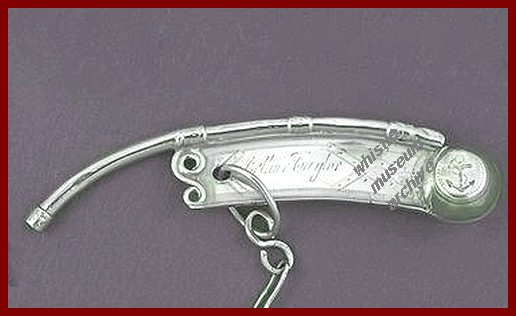
1804 Arthur Taylor
1810’s

Sterling Silver Boatswain, Buson whistle by charles rawlings 1812 London
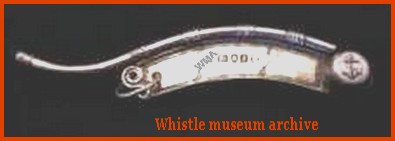
1819 Mary Chawner London
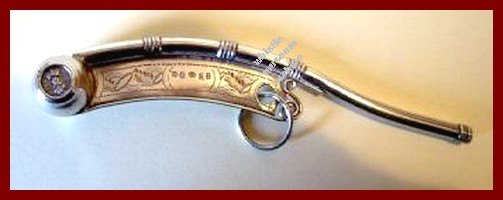
1819 Joseph Willmore Birmingham Fully Hallmarked sterling silver.

Here is a Brief History of him.
Joseph Willmore – was a grandson of Thomas Willmore who was one of silversmiths active since the establishment of Birmigham Assay Office in 1773. Thomas Willmore entered his mark at Birmingham Assay Office in partnership with James Alston between 1773 and 1801, though later marks show that both were independent silversmiths. Willmore was a bucklemaker and Alston operated as a button maker.
Joseph Willmore took over the business on Thomas’s death in 1816. Joseph had already registered his mark at Birmingham Assay Office in 1806-7 as a snuff-box maker. He also registered at London Assay Office in 1814-5 where he had a showroom in Bouverie Street and later Thavies Inn in Holborn. This fact suggests that he has distinctive sence of business. He clearly understood the importance of marketing his products to his wealthy customers living in London. Usually a silversmith delegates the marketing operation to the retailer who has close relationship with the wealty customers. However he inteds to control the marketing of his products by himself.
He registered a new hallmark at Birmingham Assay Office as a make of handles of knife and fork in 1831-2, and as a make of silver-gilt knife, fork and spoon in 1832-3.
Joseph entered into a partnership with two other Birmingham silversmiths, John Yapp and John Woodward. He died in 1855 and his buisness discontinued.
1820’s

1830’s

1837 Joseph Wilmore Birmingham
1840’s

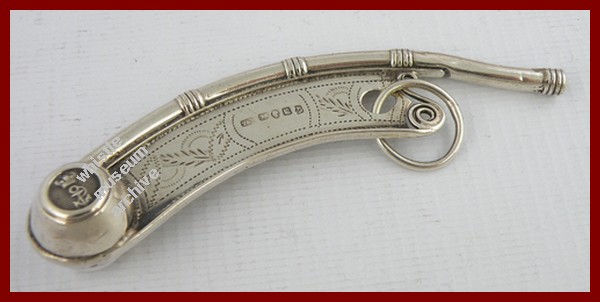
1847 Yapp & Woodward Birmingham
1850’s
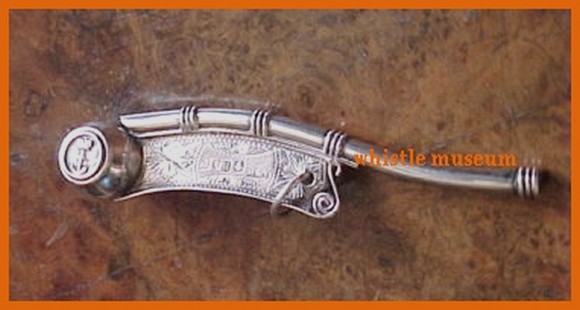
1856 Hilliard & Thomasson Birm.
1860’s

1867 SRCB Roberts & Belk (Samuel Robert & Charles Belk ) Sheffield
1870’s
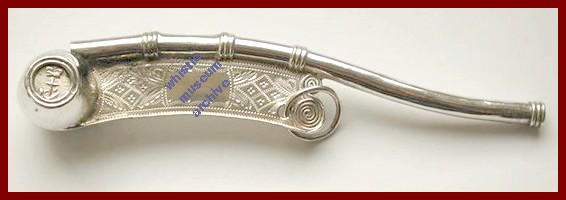
1877 H & T, Hilliard & Thomason. Bosun’s whistle, call by H & T Hilliard & Thomason. Birmingham, 1877 , fully hallmarked on other side.
H & T were well known silversmiths in Birmingham, making other types of whistles as well .
1880’s
 J H Gaunt & Sons Birmingham, earliest buson in catalog
J H Gaunt & Sons Birmingham, earliest buson in catalog
model B 414
1890’s
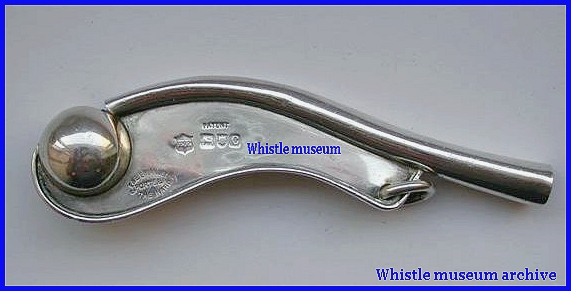 1896 E E Emmanuel Pat Number 7673
1896 E E Emmanuel Pat Number 7673
Under construction to be cont.
1900’s
H&T Hilliard & Thomason
Spencer Street, Birmingham Birmingham 1904 hallmark
xxx
A. De Courcy Patent of 10035 , 1909 Buson whistle design. nickel Plated Brass.

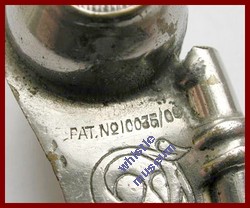
The New Era Hand made Line production
J. Hudson De Courcy, Professional Navy calls , Army militiray marine service
Full Line production with replicas and designs made for souveniers
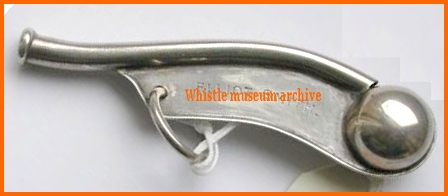
1907 George Unite, Birmingham , Bosun’s whistle.
Previous articles here and external links
There are 5 previous articles regarding Bosun’s pipe , whistles here ( currently unavailable I will reload in the future A.S )
http://whistlemuseum.com/search.aspx?q=Buson&sc=tcon&dt=a&al=
Reccomended web-site about collecting silver spoons.
http://www.antiquesilverspoons.co.uk/spoonmakers.htm
Boatswain’s call, Boatswain’s Pipe, Bosun’s whistle, 1877 H & T Silver Bosun’s call and some nice articles & web sites.A boatswain bo’s’n, bos’n, or bosun is an unlicensed member of the deck department of a merchant ship….see Wikipedia
http://en.wikipedia.org/wiki/Boatswain’s_mate_(United_States_Navy)
and Boatswain’s Pipe http://en.wikipedia.org/wiki/Boatswain’s_call
- http://whistlemuseum.com/2014/02/28/american-bosun-pipes-bosun-whistles-and-more-astrauss.aspx
-
————————————————————————————————-
“The Bosun’s Call is a metallic pipe attached to a white Lanyard and worn as part of the uniform in our Scout Troop normally by Assistant Patrol Leaders and Patrol Leaders that are proficient in piping.”
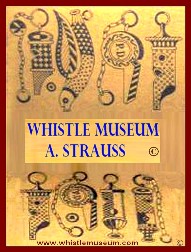
Boatswain’s call History, Timeline, Examples and More.Whistle museum, A.Strauss 2012
All rights reserved, /2009/03/22 Please do not use any part of this web page without a written permission from the author. ההיסטוריה של משרוקיות מלחים. אבנר שטראוס
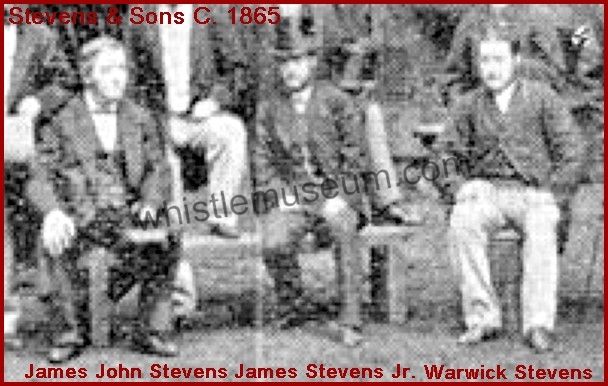
 other burials at
other burials at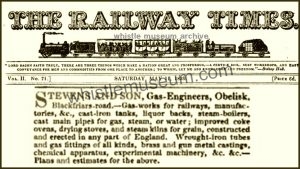 The railway Times Magazine Vol. II 1839 Adv. by Stevens & Son
The railway Times Magazine Vol. II 1839 Adv. by Stevens & Son